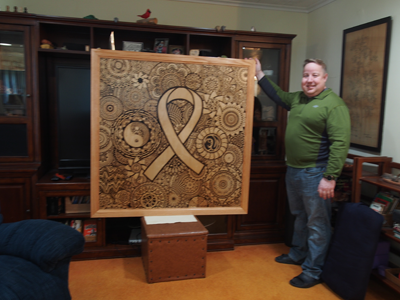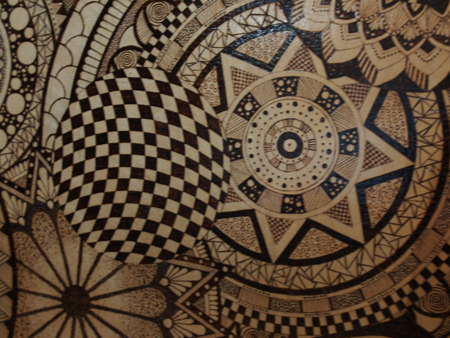Featured News - Current News - Archived News - News Categories
Story and Photos by Alice Gerard
A mandala represents a spiritual journey. Generally, it is in the form of a circle, but, on occasion, it can be a square. The circle is often chosen as the form because it has no beginning and no end. It’s geometric, and it represents the cosmos.
For Casey Dahlstrom, mandalas tell a story and, through them, he can share his vision of the world. The story that Casey tells is one of survival, hope and creativity. His medium is pyrography, which he describes as the “art of burnt wood.” On a 4-foot-by-4-foot piece of wood, he created his design and told his story.
“Pyrography,” Casey explained, “is creating art by burning wood. I have a temperature-controlled box. Depending on what kind of burn I need to accomplish, I have full control of how fast and how dark the burn can occur.
“Like a painter would have different shaped brushes, I work with different shaped pens. Anything with a flat, smooth edge, so I can accomplish shading to a sharp fine point, if I want to draw a nice, sharp line into the wood.”
Casey, who is now 34 years old, has been working with wood since a camping trip that he took with his father, Gary Dahlstrom, 25 years ago.
“At that point, we had experimented with wood carving after our Scoutmaster brought his kid along, and we had been interested,” Casey said. “From there, that evolved with working from anything from basswood to bark carvings. My mother had been an artist while growing up. She had drawn cartoons. She was the first one in the family to try pyrography, and I got extremely curious about that. About seven years ago, I attempted my first piece of an eagle on an 8-by-10 sheet of plywood. That’s evolved into a 4-foot-by-4-foot piece in seven years.”
Casey said he drew inspiration from many sources: “This pattern system is referred to as mandalas, and each one is created in that moment of time when I’m working on it. I didn’t preplan any of these.
“The only thing that was planned – and I had to think about this before the art started taking shape – is what did I want as the overall effect? I had done a piece prior to this that was half the size of this, and I had done about eight to 10 circles in that one. After learning how to do them and the different techniques I had, I decided that I wanted to go much bigger and much more detailed. With this one, I would say I easily have 50 circles buried within different spots of this art form.”
The subject matter for the circles comes from the things that he sees, Casey said, which explains the variety of designs within the circles. Some of the designs, such as a few yin-yang symbols, are repeated throughout the design.
“A lot of my inspiration comes from seeing stuff in the real world,” he said. “It could be from seeing a mosaic on a piece of tile in someone’s bathroom. It could be anything, up to the internet, including Pinterest. I had started a smaller piece, learned by experience of what I liked and didn’t like. I tried two or three more pieces after that. After a while, it just kept getting bigger and bigger and bigger until, you know what? I want to swing for the fences and go for something huge.”

Casey Dahlstrom and his project, which was created by the art form called pyrography or the art of burning wood.

A close-up image of a few of the mandalas in Casey Dahlstrom’s project.
••••••••
Although the project took nine months to create, Casey’s enthusiasm for it never waned, he reported.
“I couldn’t wait to get home and start working on this,” he said. “Each day, as I worked on each little section, I’d have random thoughts come into my mind throughout the day. I’d come home with little pieces of paper in my pocket of something I wanted to try for the next layer that I was working on. Different design choices, different shapes. I decided not to go with a traditional shading technique of showing dark to light by pure shadows. I didn’t want it to be too muddy. So, I had to find a different technique to show the darks, to show the lights. A lot of that came down to the different shapes that are within a layer. On a particular ring, you might see a lot of white, but with some cross hatching or with some dots or maybe coloring every other and making a polka dot type of theme. From a distance, when you stand back, your eye mutes all those colors together so you end up having the darks, the lights, and the mid-tones in between, as well.
“Every single detail that comes into my mind, I was literally making up as I go along, with maybe three hours’ research into an idea, with the possibility of a layer that I could add and then coming down, perhaps drawing it out, seeing if that works and then, eventually, just going for it and working it as I go.”
When asked about the ribbon at the center of the image, Casey, a cancer survivor and Relay For Life’s 2014 Honorary Survivor, said, “With this piece, I added the ribbon because I wanted this to be my piece. No one else is going to come up with something along this line. Anyone can create a mandala and add flower petals and shapes and cross hatches and whatever layer you can possibly imagine, in terms of different shapes. But when I envisioned the ribbon going in the center of this before I even began this piece, I knew that was going to be my little statement, a subtle statement of what I’ve been doing with my life. If I see this piece out there, it’s me.
“I didn’t want to add any color to it because I didn’t want the color to detract from the rest of the piece, but I also want to fight against all cancers. Cancer ribbons, when they’re colored, will usually symbolize a particular cancer. We associate pink with breast cancer. You’ll see that gold is associated with pediatrics. And so on and so forth. I just wanted this to be a universal stand and my symbol for everything that’s gone on in my lifetime and making this piece mine.”
Both Casey and Gary said that working with wood has created a strong bond between them.
Gary has created many objects from wood, including Christmas ornaments, little mice, and chess sets, with either traditional pieces or stylized pieces. One of their shared projects was a frame for Casey’s large project.
“One of the deciding factors for the size of the frame was going to be whether the frame would fit in the car later,” he said. “So, we found out that we couldn’t make the frame too much bigger because, then, the largest vehicle that we have wouldn’t allow for the image to sit inside the vehicle. So, we’re hoping to get a nice public display at the Erie County Fair this coming summer. Other than that, I honestly don’t know where this is going to go.”
Casey said his mother inspired him to get out of his comfort zone to grow as an artist: “I give my mother a lot of credit for drawing and performing pyrography in the category of portraits. She’s very good at demonstrating what a human figure should be with subtle techniques. For instance, when you’re doing cheeks, you can’t do hard lines. She’s very good at understanding where light should or should not show with the darks and the lights. It has not been might strong suit. I have done a couple of them.”
Casey said woodworking has created a bond between his father and him: “Anytime he’s working on a project in the basement or, subsequently, I’m working on a project in the basement, we often like to come down and check out each other’s work and see what progress is being made, possibly bouncing ideas off one another. I think one of the happiest moments for him, when I was completing this piece, was when he was getting his workshop back after a year of tying up his space.”
Casey has a few words of advice for people who would like to try to create art: “When you put your heart into something, you have to tune out the critics, tune out the mindset of ‘you can’t do this’ or ‘something is not supposed to happen this way.’ At some point, you have to let yourself release that nervous energy, sit down, and let your mind go wild.”
He also said that, at times, in a person’s progress as an artist, the inspiration might vanish. Finding inspiration where you can is helpful, as well as focusing on your own growth as an artist.
“One of the most difficult things about being an artist is, years down the road, when you’ve established yourself in that medium in which you’re working. The first couple of images that you’ve created, your mind can run wild because all the possibilities are out there,” he said. “Every time when you’re trying to set the bar that much higher. … I don’t produce as many wood burnings or wood carvings as I used to, but the ones that I am producing get higher in skill level, higher in experience. In this case, larger in actual size.”
Casey explained that creating art can be very joyful for both his parents and for himself.
“One of my parents’ favorite things to do in the summer is to grab their tools, head down to the water, and sit and relax for an hour, with a knife in one hand, and enjoy the nice beverage by the water,” he said.
“My favorite time is sitting down by the water with a knife in hand and a piece of wood and watching the boats go by and the noises and just relaxing and doing some carving,” Gary said. “I like carving outside in the woods and by the river, more than indoors.”





























